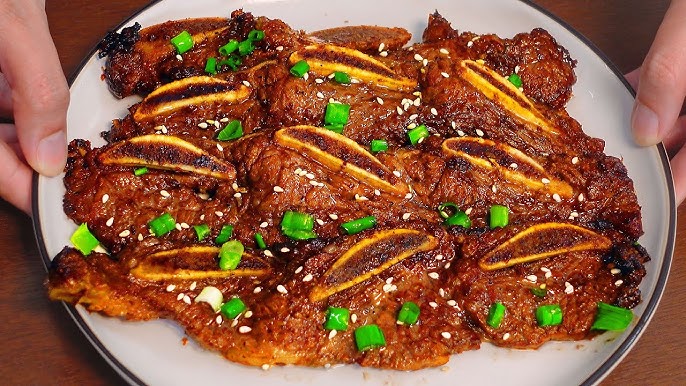Korean Beef Short Ribs Recipe: When it comes to Korean cuisine, one dish that immediately stands out for its flavor, tenderness, and mouthwatering aroma is Korean Beef Short Ribs, also known as Galbi or Kalbi. This dish has become a global favorite, not just in Korean households but also in international restaurants and home kitchens. Imagine biting into a juicy, caramelized rib, grilled to perfection, and bursting with savory-sweet flavors—that’s the magic of Korean beef short ribs.
In this guide, you’ll discover everything you need to know about preparing this dish from scratch, from selecting the right ingredients to cooking the ribs perfectly. Whether you’re a beginner in the kitchen or an experienced cook, this step-by-step recipe will help you create restaurant-quality Korean short ribs at home.
What Are Korean Beef Short Ribs?
Korean beef short ribs, traditionally called Galbi (갈비), are a staple in Korean BBQ. The term “Galbi” literally translates to “ribs” in Korean. These ribs are unique because of the way they’re cut—across the bone rather than parallel to it, creating thin slices of beef with cross-sections of bone. This special cut, often called the “flanken cut” or “LA Galbi,” allows the meat to cook quickly while absorbing the marinade more effectively.
The flavor profile of Korean beef short ribs is a delightful balance of salty soy sauce, sweet sugar or honey, nutty sesame oil, and a hint of garlic and ginger. Together, these ingredients create a rich marinade that seeps deep into the meat, making every bite flavorful and tender.
Unlike Western-style short ribs that are slow-braised, Korean short ribs are usually grilled or pan-seared for a smoky, charred flavor. That’s why they’re a centerpiece at Korean BBQ restaurants, where diners gather around sizzling grills and cook their own meat at the table.
Why This Dish Is Loved Worldwide
The popularity of Korean beef short ribs extends far beyond Korea’s borders, and for good reason. First, the taste is unforgettable—it’s a perfect combination of umami, sweetness, and smokiness that keeps you coming back for more. Second, the versatility makes it appealing; you can grill them outdoors in the summer, pan-fry them in your kitchen, or even bake them in the oven.
Moreover, this dish embodies the spirit of Korean dining culture—family, sharing, and enjoying food together. Serving Korean short ribs often means gathering around a table with loved ones, sharing laughter, and indulging in delicious bites of juicy meat paired with vibrant side dishes (banchan).
It’s not just a recipe; it’s an experience. And once you try it, you’ll see why it’s one of the most beloved Korean dishes worldwide.
Ingredients You’ll Need for Korean Beef Short Ribs
Before we dive into cooking, let’s get your kitchen stocked with everything you’ll need. The beauty of this recipe is that most of the ingredients are pantry staples, and a quick trip to your local Asian grocery store will cover the rest.
Essential Ingredients for the Marinade
The secret behind mouthwatering Korean beef short ribs lies in the marinade. Here’s what you’ll need:
- Soy Sauce – The base of the marinade; adds saltiness and umami depth.
- Brown Sugar or Honey – Sweetens the ribs and helps caramelize during cooking.
- Garlic (minced) – For a strong aromatic flavor.
- Ginger (grated or minced) – Adds warmth and a slight spice.
- Sesame Oil – Nutty, rich flavor that’s essential to Korean cooking.
- Green Onions – Fresh, slightly sharp flavor.
- Pear or Apple (grated) – A traditional Korean secret; it tenderizes the meat while adding natural sweetness.
- Rice Wine or Mirin (optional) – Enhances flavor complexity.
- Sesame Seeds – For garnish and extra nuttiness.
These ingredients work together to create a marinade that penetrates deeply into the beef, ensuring every bite is tender, juicy, and full of flavor.
Meat Selection – Choosing the Right Short Ribs
The star of this dish is, of course, the beef short ribs. But not just any short ribs will do. For Korean-style ribs, you’ll need flanken-cut beef short ribs. This cut slices across the bones, leaving thin strips of meat with little bone pieces running through them.
Why flanken cut? Because it cooks quickly, absorbs marinade beautifully, and provides a perfect balance of tender meat and rich beefy flavor. If you can’t find flanken-cut ribs at your local grocery store, try visiting a Korean or Asian market—they almost always carry them.
If you prefer, you can also use English-cut short ribs, which are thicker and meatier, but they require a longer cooking time (such as braising or slow-cooking). For this recipe, though, the flanken cut is ideal.
Optional Add-Ons to Enhance Flavor
While the classic marinade is already incredible, you can always experiment with additional ingredients to customize the flavor to your liking. Some optional add-ons include:
- Chili flakes or Gochujang (Korean chili paste): For a spicy kick.
- Coca-Cola or Sprite: A common Korean BBQ hack—adds sweetness and helps tenderize the meat.
- Onions (sliced): To enhance the savory flavor and add caramelization.
- Fresh herbs like cilantro: For a refreshing twist.
These add-ons aren’t necessary, but they can take your dish to another level if you’re feeling adventurous.
Step-by-Step Guide to Cooking Korean Beef Short Ribs
Cooking Korean beef short ribs is easier than you might think. With the right preparation and steps, you’ll achieve ribs that are flavorful, tender, and grilled to perfection.
Step 1 – Preparing the Marinade
The secret to delicious Korean beef short ribs is the marinade. In a mixing bowl, combine soy sauce, brown sugar (or honey), minced garlic, grated ginger, sesame oil, and rice wine or mirin. For extra flavor, add finely chopped scallions, a pinch of black pepper, and an optional pear or apple puree (this helps tenderize the meat while adding natural sweetness). Stir until everything is well mixed.
Step 2 – Marinating the Beef Ribs
Place the beef short ribs into a large resealable bag or shallow dish. Pour the marinade over the ribs, making sure each piece is coated evenly. Seal the bag or cover the dish, then refrigerate for at least 4 hours—overnight works best for maximum flavor. Turn the ribs occasionally so the marinade soaks through evenly.
Step 3 – Cooking Methods (Grilling, Pan-Seared, Oven-Baked)
There are several ways to cook Korean short ribs, depending on your preference:
- Grilling (Traditional Method): Preheat your grill to medium-high heat. Place the marinated ribs directly on the grill and cook for about 3–4 minutes per side until caramelized and slightly charred.
- Pan-Seared: Heat a heavy skillet or grill pan over medium-high heat. Add a small drizzle of oil, then sear the ribs for 3–4 minutes on each side until golden brown.
- Oven-Baked: Preheat the oven to 375°F (190°C). Arrange the ribs on a lined baking sheet and bake for 20–25 minutes, flipping halfway through, until they are fully cooked and slightly crispy around the edges.
Step 4 – Resting and Serving the Ribs
Once cooked, remove the ribs from the heat and let them rest for a few minutes to lock in the juices. Garnish with toasted sesame seeds and freshly chopped scallions. Serve hot with steamed rice, kimchi, and other Korean side dishes (banchan) for an authentic experience.
Tips for Perfect Korean Short Ribs
Now that you know the cooking process, let’s talk about what separates “good” ribs from unforgettable ones.
How Long Should You Marinate?
The key to flavorful Galbi lies in the marination time. While a minimum of 2 hours can give you a decent flavor, the magic really happens when you marinate for 12 to 24 hours. The soy sauce deeply seasons the meat, the sugar helps with caramelization, and the grated pear or apple naturally tenderizes the beef.
If you’re planning a dinner party or family gathering, prepare the marinade the night before and let the ribs soak overnight. Trust me, your taste buds will thank you.
Balancing Sweet, Salty, and Savory Flavors
Getting the balance right in your marinade is crucial. Korean cuisine is all about harmony—no single flavor should overpower the others. Here are a few quick adjustments you can make depending on your preference:
- Too salty? Add more grated pear or apple, or a splash of water.
- Too sweet? Add a touch more soy sauce or rice wine vinegar.
- Missing depth? A teaspoon of fish sauce or miso paste can add incredible umami richness.
Remember, the marinade should taste good on its own—that’s your best indicator that your ribs will turn out delicious.
Serving Suggestions
Korean short ribs aren’t just about the meat; they’re about the whole dining experience. The way you serve them can make the meal feel even more special.
Side Dishes to Serve with Korean Beef Short Ribs
In Korean cuisine, meals are rarely about just one dish. Instead, they come with several small side dishes called banchan. Here are some popular pairings for your Galbi:
- Kimchi – Fermented cabbage with a spicy, tangy kick.
- Japchae – Stir-fried glass noodles with vegetables.
- Korean Potato Salad – Creamy and slightly sweet.
- Pickled Radish (Danmuji) – Refreshing and crunchy.
- Steamed Rice – A must-have; it balances the strong flavors of the ribs.
If you want a more casual vibe, you can also serve the ribs with lettuce wraps. Simply place a piece of rib meat in a lettuce leaf, add a spoonful of rice, a dab of ssamjang (Korean dipping sauce), and maybe a slice of kimchi. Wrap it up and enjoy—it’s like a flavor explosion in one bite.
Pairing with Drinks and Sauces
To complete the experience, pair your Korean short ribs with drinks like:
- Soju – A Korean favorite, smooth and slightly sweet.
- Beer – Light lagers or crisp ales complement the smoky, savory ribs.
- Non-Alcoholic Options – Try barley tea (boricha) or sparkling water with lemon for a refreshing twist.
As for sauces, a little extra ssamjang or spicy gochujang sauce on the side is always welcome.
Nutritional Information
Korean beef short ribs are indulgent, but it’s always good to know what’s going into your body. The exact nutritional breakdown depends on portion size and cooking method, but here’s a general idea per serving (about 3–4 ounces of cooked ribs):
- Calories: 350–400
- Protein: 20–25g
- Fat: 25–30g
- Carbohydrates: 8–12g (from marinade)
- Sodium: 600–800mg (mainly from soy sauce)
Making a Healthier Version
If you’re watching your diet, you can still enjoy Korean short ribs with a few tweaks:
- Use low-sodium soy sauce to cut down on salt.
- Swap out sugar for honey or coconut sugar for a more natural sweetener.
- Trim excess fat from the ribs before marinating.
- Serve with more vegetables and smaller portions of rice to balance out the meal.
These simple adjustments make the dish lighter without compromising on flavor.
Common Mistakes to Avoid
Even with a simple recipe like Korean beef short ribs, small mistakes can make the difference between tender, flavorful meat and tough, disappointing bites. Let’s look at some common pitfalls and how to avoid them.
Overcooking or Undercooking the Ribs
Because Korean short ribs are cut thin, they don’t take long to cook. Overcooking can quickly dry them out, leaving you with chewy meat instead of juicy, tender bites. On the flip side, undercooking leaves the meat raw near the bone, which isn’t appetizing either.
The key is to cook them quickly over medium-high heat until the surface is caramelized but the inside is just cooked through. Usually, 4–5 minutes per side on a grill or pan is all you need. Always keep an eye on them—short ribs cook faster than you might think.
Using the Wrong Cut of Meat
Korean-style short ribs call for flanken-cut ribs. If you mistakenly use thick English-cut short ribs, you’ll end up with tough meat that takes hours of braising instead of minutes of grilling. Make sure to ask your butcher specifically for thin-cut beef short ribs if you’re unsure.
Skipping the Marinade or Rushing It
The marinade isn’t optional—it’s what makes this dish truly Korean. Skipping it or marinating for too short a time won’t give the meat the depth of flavor or tenderness that defines Galbi. Ideally, let the ribs sit in the marinade overnight. If you’re pressed for time, aim for at least 4–6 hours.
Crowding the Pan or Grill
When cooking, don’t overcrowd the ribs. Too many pieces in the pan or on the grill will steam instead of sear the meat, preventing that caramelized crust. Cook in batches if necessary—it’s worth the extra time.
Storing and Reheating Korean Beef Short Ribs
If you’ve made a large batch of Korean beef short ribs, you’ll probably have some leftovers. The good news is, they store and reheat beautifully when done the right way.
Best Way to Store Leftovers
After cooking, let the ribs cool to room temperature. Store them in an airtight container in the refrigerator for up to 3–4 days. If you want to keep them longer, freeze them. Place cooled ribs in a freezer-safe bag or container, and they’ll last for up to 2 months. Just make sure to label the container so you remember when you made them.
If you’re freezing uncooked, marinated ribs, even better! They’ll soak in the flavors while frozen, and when thawed, they’ll taste just as good (if not better).
How to Reheat Without Losing Flavor
Reheating meat can sometimes dry it out, but not if you use the right method. Here are some options:
- Stovetop: Add a splash of water or leftover marinade to a pan, cover, and heat gently until warmed through.
- Oven: Preheat your oven to 300°F (150°C). Place the ribs on a baking sheet, cover with foil, and warm for 10–15 minutes.
- Microwave: This is the quickest method, but be careful. Reheat in short bursts, and cover with a damp paper towel to retain moisture.
By reheating gently, you’ll keep the meat tender and flavorful, just like when it was freshly cooked.
FAQs about Korean Beef Short Ribs Recipe
1. Can I make Korean Beef Short Ribs without soy sauce?
Yes, you can substitute soy sauce with tamari (gluten-free option) or coconut aminos for a lower-sodium, slightly sweeter alternative.
2. How long should short ribs be marinated?
For the best results, marinate for 12–24 hours. If you’re short on time, aim for at least 4–6 hours.
3. Can I cook Korean short ribs in the oven?
Absolutely! Bake at 375°F (190°C) for 25–30 minutes, flipping halfway through. For extra char, broil them for the last few minutes.
4. What is the difference between LA Galbi and traditional Galbi?
LA Galbi uses flanken-cut ribs (cut across the bone), making them thinner and faster to cook. Traditional Galbi uses thicker cuts that require longer cooking methods.
5. Can I freeze marinated Korean short ribs?
Yes! In fact, freezing them in the marinade allows the flavors to penetrate even more. Just thaw before cooking.
Conclusion
By following this step-by-step guide, you now have the tools to make authentic Korean short ribs in your own kitchen. From choosing the right cut of beef to preparing the perfect marinade and cooking them to perfection, every step brings you closer to a restaurant-quality dish.
Whether you grill them outdoors with friends, pan-sear them for a quick dinner, or bake them in the oven for convenience, one thing is guaranteed: these ribs will disappear fast! Pair them with traditional side dishes, serve with rice and lettuce wraps, and enjoy the full Korean BBQ experience.
So, the next time you’re craving something bold, savory, and satisfying, give this recipe a try. Your family and friends will thank you, and you just might find yourself making it again and again.



